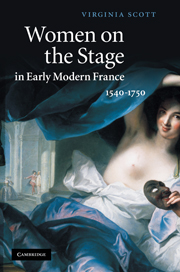Book contents
- Frontmatter
- Contents
- Acknowledgments
- Introduction
- 1 The actress and the anecdote
- 2 “So perverse was her wantonness”: antitheatricalism and the actress
- 3 In the beginning: “12 livres per year”
- 4 “Those diverting little ways”: 1630–1640
- 5 Mademoiselle L'Étoile: 1640–1700
- 6 “Embellished by art”: 1680–1720
- 7 Lives and afterlives: 1700–2010
- Bibliography
- Index
5 - Mademoiselle L'Étoile: 1640–1700
Published online by Cambridge University Press: 03 May 2011
- Frontmatter
- Contents
- Acknowledgments
- Introduction
- 1 The actress and the anecdote
- 2 “So perverse was her wantonness”: antitheatricalism and the actress
- 3 In the beginning: “12 livres per year”
- 4 “Those diverting little ways”: 1630–1640
- 5 Mademoiselle L'Étoile: 1640–1700
- 6 “Embellished by art”: 1680–1720
- 7 Lives and afterlives: 1700–2010
- Bibliography
- Index
Summary
When Paul Scarron baptized the leading lady of his profoundly provincial theatrical troupe “Mademoiselle de L'Étoile” in Le Roman comique in 1651, we might think he was verging on irony. In fact, the word “star,” meaning an actor or actress distinguished by his or her celebrity, seems to have entered English usage only in the nineteenth century and to have been borrowed by the French in the twentieth. Scarron's pairing of Mlle de L'Étoile with her partner, Le Destin, plays rather on an earlier meaning of étoile, as in Shakespeare's “a star danced and under that I was born.” Both “Destin” and “Étoile” imply that fate rather than choice has determined their profession. But in fact, if not in lexicography, the “star,” that is, someone notably conspicuous for professional accomplishments and celebrity, was born in France over the course of the last half of the seventeenth century.
A “star” displays some fairly obvious characteristics. Perhaps the most important one is that audiences are drawn to star performances, increasing the financial rewards for everyone involved. Another sign of stardom is when playwrights write specific roles to feature the biggest draws. In the seventeenth century, the two great star-makers were Molière and Racine. Of course, Molière primarily wrote plays that featured Molière, but he also established the stardom of his wife, Armande Béjart, with roles like the Princesse d'Élide, Psyché, Célimène, and Elmire.
- Type
- Chapter
- Information
- Women on the Stage in Early Modern France1540–1750, pp. 142 - 197Publisher: Cambridge University PressPrint publication year: 2010



